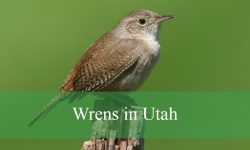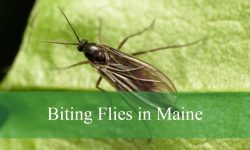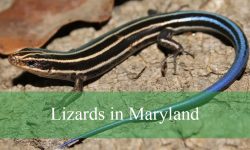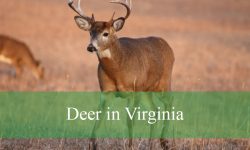Utah is home to a rich variety of bird species that bring color and life to its diverse landscapes. From soaring raptors to cheerful songbirds, the Birds in Utah offer endless opportunities for nature lovers and birdwatchers to explore and enjoy. Hiking through mountain forests or strolling along wetlands, many familiar feathered friends can be spotted.
Birds in Utah thrive in habitats ranging from desert canyons to lush riparian areas, making the state a vibrant hotspot for birdwatching throughout the year. This guide introduces 45 common birds in Utah, complete with pictures and identification tips to help you recognize each species easily. Understanding these birds enriches outdoor adventures and deepens the connection to the natural world.
Learning about these Birds in Utah provides insight into their behaviors, songs, and preferred environments. For beginners and experienced birders alike, this collection inspires a closer look and greater appreciation for the amazing birdlife that makes Utah truly special.
Common Found Birds in Utah
California Gull (State Bird of Utah)
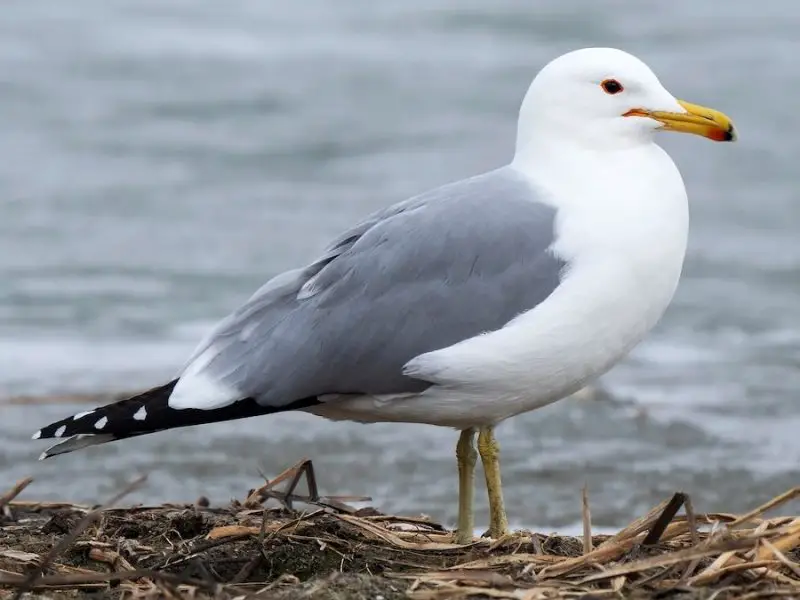
The California Gull is a medium-sized gull with a clean white head, neck, and underparts contrasted by gray wings and a black wingtips pattern. Its yellow bill features a distinctive black ring near the tip during the breeding season, and its legs are greenish-yellow. Adults measure about 20–23 inches long with a wingspan reaching up to 50 inches. Juveniles appear mottled brown and gradually acquire adult plumage over several years.
This species is known for its varied and somewhat harsh vocalizations, including a mewing “keow” and repeated “kleeaah” or “kyeowk” calls, often given in flight or during social interaction. California Gulls are opportunistic foragers and display versatile feeding behaviors, ranging from scavenging at landfills to capturing insects and fish. In Utah, they are famously remembered for helping early Mormon settlers by eating crop-destroying crickets, earning their designation as the state bird.
California Gulls are widely distributed across Utah, especially near freshwater lakes and reservoirs such as the Great Salt Lake and Utah Lake. They breed in large colonies on islands and remote lake shores and are most commonly seen from spring through fall. Their preference for open areas with abundant food and water makes them frequent visitors to parking lots, agricultural fields, and shorelines across the state.
American Robin
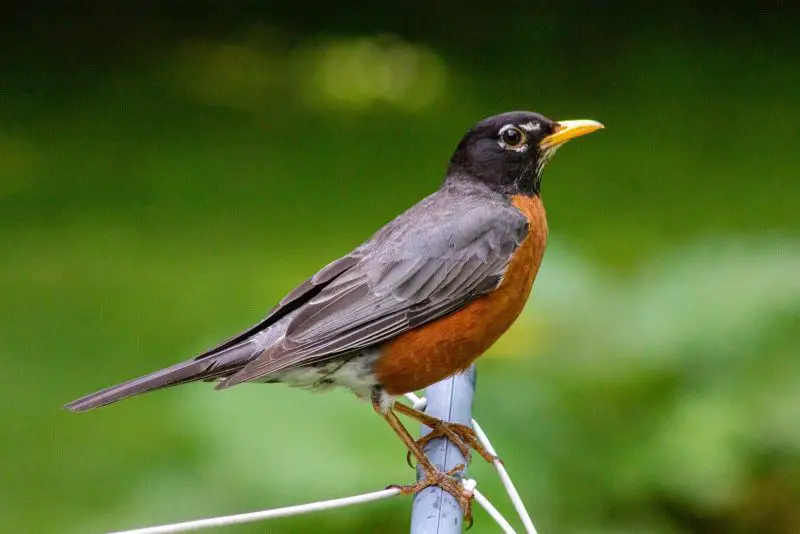
The American Robin is one of the most familiar birds in Utah, instantly recognized by its bright reddish-orange breast, gray-brown upperparts, and yellow bill. Males are slightly more vivid than females, and both sexes have a white patch under the tail and bold white eye arcs. These medium-sized songbirds measure about 9–11 inches long with a wingspan around 12–16 inches.
Robins are known for their rich, melodic caroling—especially in the early morning hours. Their song is a series of warbled phrases that sound like “cheerily, cheer up, cheer up, cheerily.” In addition to their song, they emit sharp “tut” or “peek” calls when alarmed. They are ground foragers, often seen running and pausing as they search for earthworms, insects, and berries. During breeding season, males become highly territorial and may be seen puffing up their red breasts in display.
American Robins are widespread throughout Utah in both rural and urban settings. They thrive in lawns, woodlands, gardens, and even deserts with sufficient vegetation. In winter, they often form large flocks and shift their diet to fruit and berries. While some migrate south, many robins remain in Utah year-round, especially in milder areas of the state.
House Finch
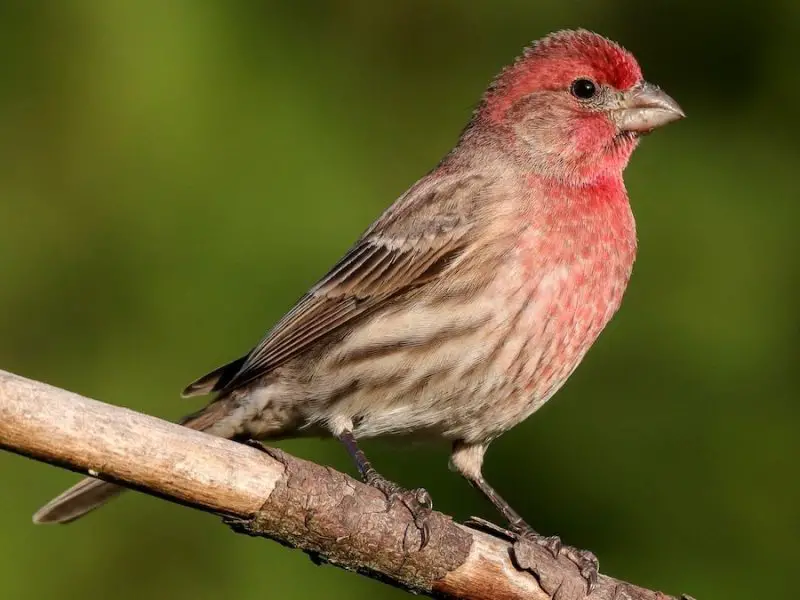
House Finches are small, colorful birds that are highly adaptable to both wild and urban environments in Utah. Males are easily identified by their rosy red foreheads, throats, and chests, which contrast with brown-streaked backs and flanks. Females lack red coloring and are uniformly brown with dense streaks. They measure about 5–6 inches long with a wingspan of roughly 8–10 inches.
Their song is a long, cheerful warble composed of rapid, rising and falling notes, sometimes ending with a harsh “cheep.” House Finches are sociable and often found in small flocks, particularly at backyard feeders where they consume seeds, fruits, and buds. Males sing from high perches to attract mates and defend territories, while females tend to stay lower, especially when nesting.
In Utah, House Finches are year-round residents and are one of the most common feeder birds in cities like Salt Lake City, Ogden, and Provo. They are also widespread in deserts, foothills, and open woodlands. Their adaptability has allowed them to expand into a variety of human-modified habitats, making them a constant presence in both developed and wild areas of the state.
Black-billed Magpie

The Black-billed Magpie is a striking, large songbird with bold black-and-white plumage and long, iridescent blue-green tail feathers. Their sturdy black bills and white shoulder patches are distinctive field marks. Adults reach about 17–24 inches in length, nearly half of which is the tail, and have a wingspan between 22–24 inches.
Magpies have a wide range of harsh, chatty calls including “wack-wack-wack” and scolding “mag-mag-mag.” While not traditionally musical, their vocalizations serve important social functions. Black-billed Magpies are intelligent and curious, often seen scavenging carrion, stealing shiny objects, or foraging for insects and small vertebrates. They are also known for building large, domed stick nests in trees and shrubs, often lined with soft materials.
These birds are common throughout northern and central Utah, especially in open country, farmlands, and near human settlements. They are often seen along roadsides, in suburban neighborhoods, and in rangelands. Their adaptability and bold behavior make them a familiar sight across the state, particularly in the Wasatch Front and Cache Valley regions.
Mourning Dove
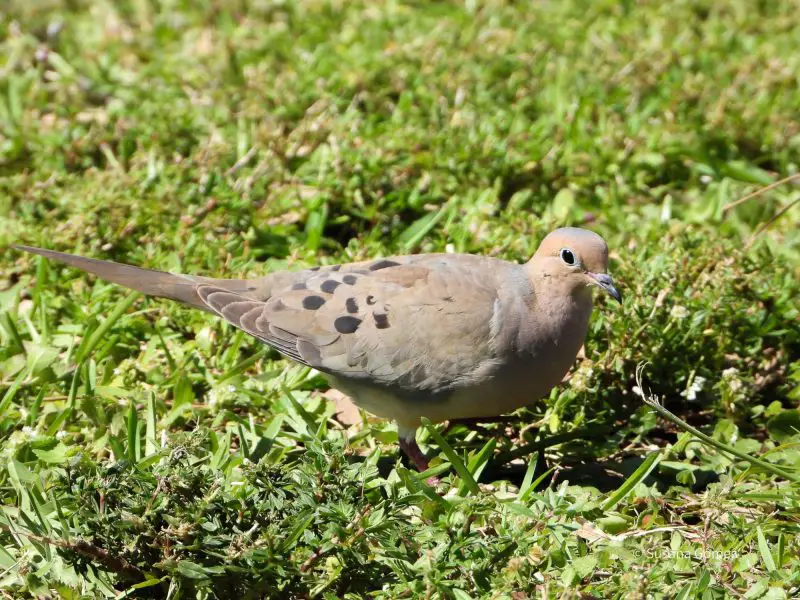
The Mourning Dove is a graceful, slender bird with light brown to buffy-gray plumage and subtle black spots on the wings. Its small head, pointed tail with white edges, and soft pinkish hue on the breast make it easily recognizable. Adults measure about 9–13 inches long with a wingspan of 17–18 inches. They have dark eyes and a gentle expression, fitting their name.
Their cooing call is a mournful “hoo-AH-hoo-hoo-hoo,” often heard in the early morning or at dusk. This call gives the species its common name. Mourning Doves also produce sharp whistling sounds with their wings when they take flight. They are commonly seen foraging for seeds on the ground and are known for their swift, direct flight pattern.
In Utah, Mourning Doves are widespread across the state, inhabiting deserts, agricultural lands, suburban yards, and open woodlands. They are especially common in the warmer months but can be found year-round in southern regions. Their adaptability, soft vocalizations, and elegant presence make them one of Utah’s most beloved and widespread bird species.
European Starling
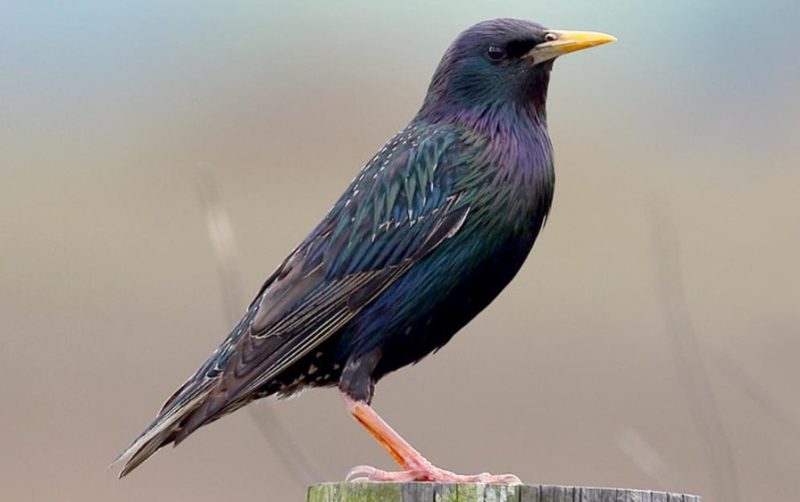
The European Starling is a medium-sized songbird with glossy, iridescent black plumage that shimmers green and purple in sunlight. During winter, their feathers are speckled with white spots, giving them a distinct look. They have short tails, pointed wings, and long, slender yellow bills that turn dark in winter. Adults typically measure 7.5–9 inches in length with a wingspan around 12–16 inches.
Starlings are known for their wide range of vocalizations, including whistles, rattles, and mimicry of other birds. They are capable of imitating mechanical sounds and the calls of other species. Highly social, they often gather in large flocks called murmurations, creating mesmerizing aerial displays. Starlings are aggressive competitors and may displace native birds from nest cavities.
European Starlings are common throughout Utah year-round, thriving in cities, farmland, and open country. They are particularly abundant along the Wasatch Front and in agricultural regions. Originally introduced from Europe in the 1890s, they have since spread across North America, adapting easily to urban and suburban settings where they forage on insects, fruits, and grains.
Dark-eyed Junco

The Dark-eyed Junco is a small, round-bodied sparrow known for its soft gray or slate-colored upperparts and crisp white belly. Utah is home mainly to the “Oregon” form, which has a dark hood, warm brown back, and pink bill. Some individuals may show different regional variations. They average about 5–6.5 inches in length with a wingspan of 7–10 inches.
Their call is a sharp “tick” or “chip,” and their song is a musical trill, similar to that of a Chipping Sparrow but often shorter. These birds forage primarily on the ground, hopping around in leaf litter to search for seeds and insects. They are also frequent visitors to backyard feeders, especially during the winter months when they gather in loose flocks.
Dark-eyed Juncos are common winter residents across Utah, especially in valleys, foothills, and forest edges. In the summer, they breed in higher elevations such as the Wasatch Mountains, nesting on the ground in cool, forested habitats. Their seasonal movements make them one of the most frequently seen sparrows during Utah’s colder months.
Mountain Bluebird
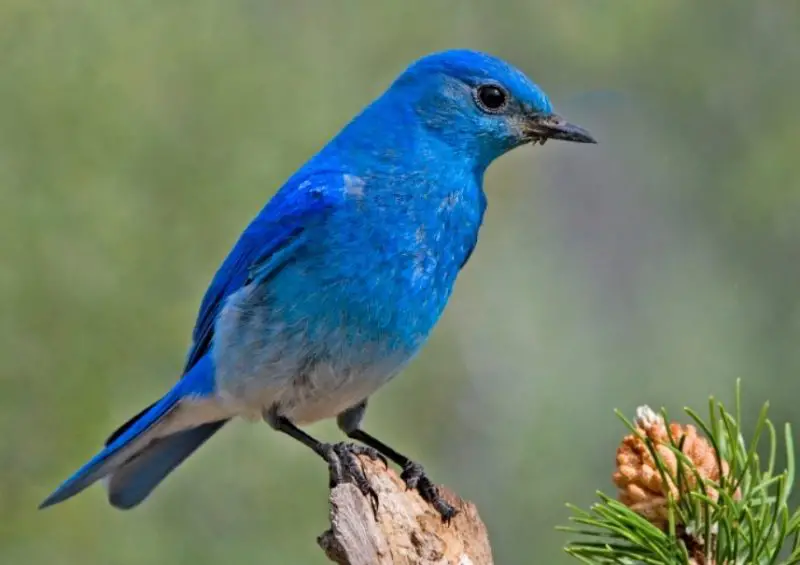
The Mountain Bluebird is a stunning thrush, with males showcasing bright sky-blue plumage across their bodies and slightly lighter underparts. Females are more subdued, with grayish-brown bodies and touches of blue on the wings and tail. Adults measure about 6.5–7.5 inches long with a wingspan of around 12 inches. Their vibrant colors and graceful flight make them a favorite among bird watchers.
These birds produce a soft warbled song made up of sweet whistles and chur notes, and their call is a simple “tew” sound. Mountain Bluebirds are cavity nesters and often use old woodpecker holes or nest boxes. They are insectivorous during the breeding season, catching insects in midair or pouncing on them from perches, while shifting to berries in colder months.
Mountain Bluebirds are found throughout Utah, especially in open grasslands, sagebrush steppe, meadows, and high deserts. They are especially abundant in areas like Antelope Island, the Uinta Basin, and the western edge of the Rockies. They are present year-round in southern Utah but migrate altitudinally to breed at higher elevations in spring and summer.
Red-winged Blackbird
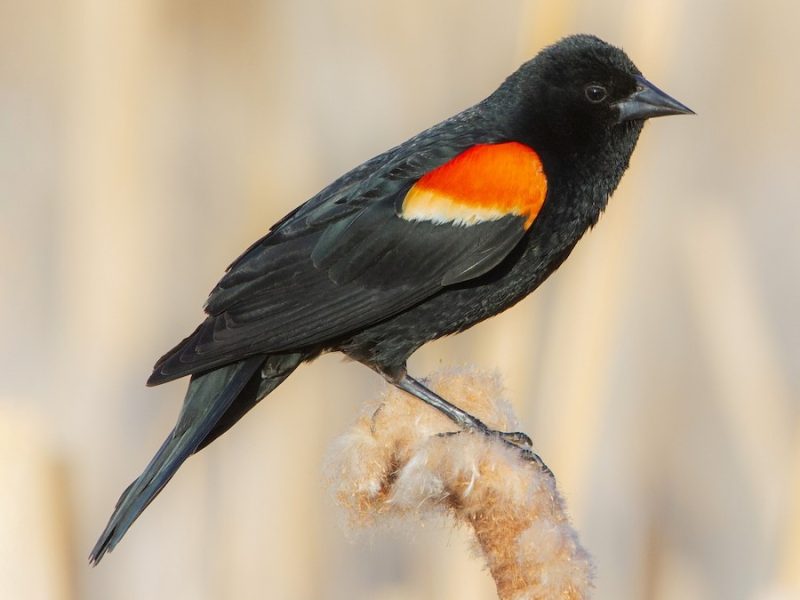
The Red-winged Blackbird is a striking medium-sized bird, with males easily identified by their glossy black bodies and bold red-and-yellow shoulder patches, called epaulets. Females are heavily streaked brown, resembling large sparrows. These birds average 7–9 inches long with wingspans of 12–16 inches. Males often perch high and flash their epaulets while singing.
Their song is a distinctive, nasally “conk-a-ree!” followed by a short trill, while calls include sharp “check” notes. Males are highly territorial during the breeding season, often displaying aggressively to intruders. They nest in dense marsh vegetation, weaving cup-shaped nests among reeds or cattails, and are frequently seen in large flocks outside the breeding season.
In Utah, Red-winged Blackbirds are widespread near wetlands, ponds, marshes, and irrigated fields. They are common in the Great Salt Lake basin and agricultural zones throughout the state. While most individuals migrate to lower elevations in winter, many remain in Utah year-round, forming flocks with other blackbirds and starlings.
Song Sparrow
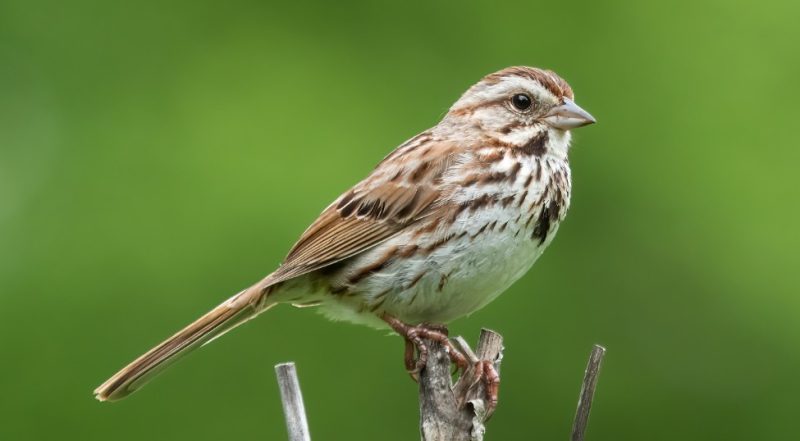
The Song Sparrow is a small, sturdy sparrow with brown and gray streaked plumage and a distinctive dark central spot on the chest. They exhibit a highly variable appearance across regions, but most in Utah have bold streaking and a rounded tail. Adults measure about 5–7 inches in length with a wingspan of 7–9 inches. Their earthy tones provide excellent camouflage among low vegetation.
As their name implies, Song Sparrows have a beautiful, complex song—a mix of clear notes and trills often starting with two or three introductory notes. Their call is a sharp “chimp” or “tchep.” Males sing persistently during breeding season, often from elevated perches. These birds forage on the ground for seeds, insects, and berries and are known to be shy but persistent feeders.
Song Sparrows are found throughout Utah in a wide range of habitats including riparian areas, shrubby wetlands, suburban gardens, and sagebrush flats. They are especially common along streams and rivers, where they build their nests in low shrubs. Some populations are year-round residents in milder regions, while others migrate to breed in the mountains during summer.
Northern Flicker
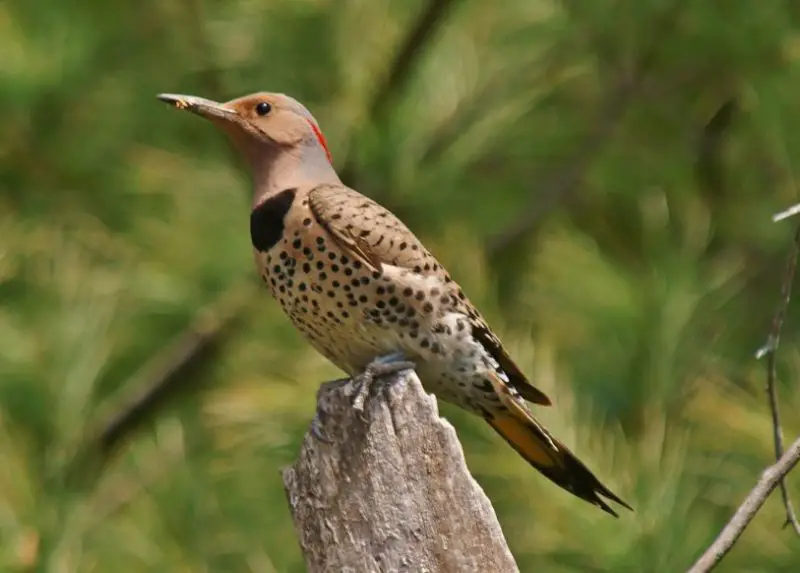
The Northern Flicker is a large, distinctive woodpecker with a sleek body, rounded head, and gently curved bill. In Utah, the “red-shafted” form is most common, marked by a gray face, tan to brown body with black spots, and vivid red underwings and tail feathers visible in flight. They have a bold black crescent on the chest and are around 11–14 inches long, with a wingspan of 17–21 inches.
Their vocalizations include a loud, ringing “kleer!” and a long series of rhythmic “wick-a-wick-a-wick” notes. Northern Flickers also produce drumming sounds on trees or metal surfaces, particularly during breeding season. Unlike many woodpeckers, they often forage on the ground, using their long tongues to extract ants and beetles from the soil.
Northern Flickers are widely distributed across Utah in woodlands, urban parks, deserts with scattered trees, and mountain forests. They are year-round residents in many areas, including along the Wasatch Front and in the high desert plateaus. Their adaptability to both natural and human-modified habitats makes them one of the more frequently observed woodpeckers in the state.
American Goldfinch
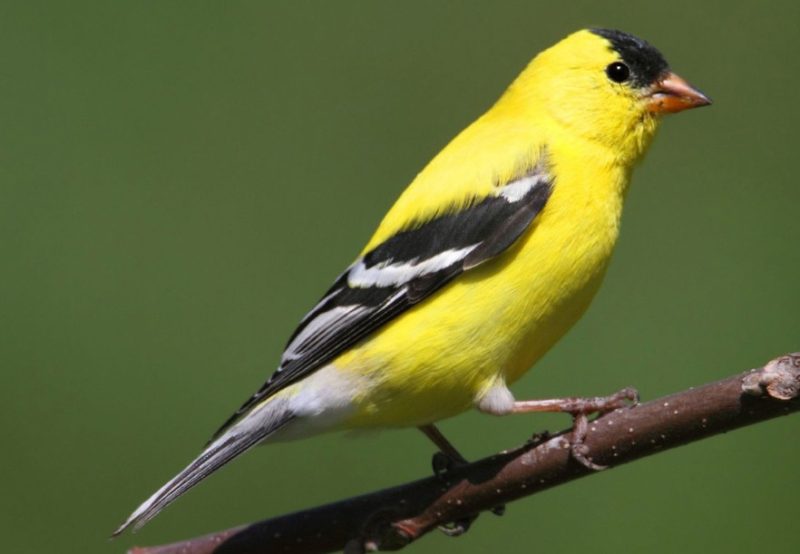
The American Goldfinch is a small, vibrant finch, most recognizable in summer when males display bright yellow plumage, a black forehead, black wings with white markings, and a short conical bill. Females are duller, with olive-brown tones and pale yellow underparts. In winter, both sexes adopt a more muted brown coloration. They measure about 4.5–5 inches in length, with a wingspan of 7.5–8.5 inches.
Their song is a cheerful, sweet warble often delivered in flight or while perched. Their flight call sounds like “per-chick-o-ree,” giving rise to the nickname “wild canary.” Goldfinches are seed specialists and frequent visitors to feeders, especially those stocked with sunflower or nyjer seeds. They are late nesters, waiting until midsummer when thistle and other seed-bearing plants are abundant.
In Utah, American Goldfinches are found across the northern and central parts of the state during the breeding season, especially in open weedy fields, suburban gardens, and riparian areas. Some individuals remain year-round in milder valleys, while others migrate to lower elevations or farther south for the winter. They are less common in Utah’s driest desert regions.
Spotted Towhee

The Spotted Towhee is a striking, large sparrow with bold coloration and a long tail. Adults have black heads, backs, and tails, with prominent white spots on the wings and back, a rufous-orange flank, and a white belly. Females are similarly patterned but with more brownish-black tones. These birds measure about 7–8.5 inches in length and have a wingspan around 10.5 inches.
Spotted Towhees produce a buzzy trill followed by a high-pitched “chewink” or “tow-hee” call, often heard from low branches or dense shrubs. Males sing loudly to defend their territory, while both sexes use scuffing foot motions to uncover insects and seeds in leaf litter. Their foraging style often gives away their presence before they’re seen.
These birds are widespread throughout Utah, especially in brushy hillsides, canyon bottoms, and forest edges with dense undergrowth. They breed in both low-elevation shrublands and higher mountain slopes, particularly in the Wasatch and Uinta ranges. Many individuals remain in the state year-round, although some may shift altitudes with the seasons.
Yellow Warbler

The Yellow Warbler is a small, brilliant yellow songbird with smooth, rounded contours and a slender, slightly downcurved bill. Males in breeding plumage are bright golden-yellow with faint red streaks on the chest, while females are paler and more uniform in color. These birds measure about 4.5–5 inches long, with a wingspan around 6.5–8 inches.
Their song is a lively, whistled series of notes that sounds like “sweet-sweet-sweet, I’m so sweet!”—a cheerful refrain often heard repeatedly throughout spring and early summer. Yellow Warblers are insectivorous and actively glean caterpillars and other bugs from foliage. They are quick, flitting birds that often forage in willow thickets, cottonwood stands, and other leafy environments.
In Utah, Yellow Warblers are common summer residents in riparian areas, wetlands, and shrubby woodlands statewide. They nest in low branches near water and are especially abundant along streams and in green corridors from the low deserts to mountain valleys. They migrate south for the winter, often departing Utah by late August or September.
House Sparrow
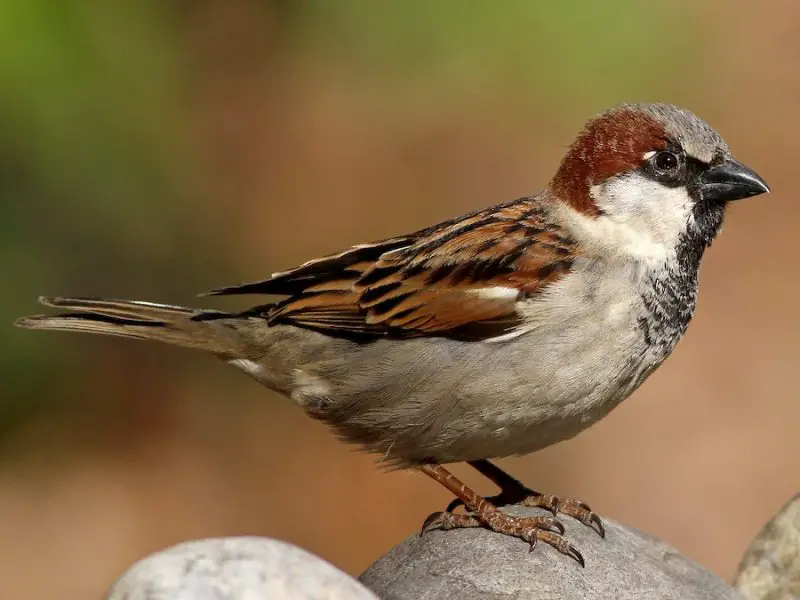
The House Sparrow is a familiar, medium-sized songbird that has adapted extremely well to human environments. Males are easily recognized by their gray crowns, chestnut napes, black bibs, and gray underparts. Females and juveniles are plainer, with brown and gray streaks and a buffy eye stripe. Adults measure around 6–6.5 inches long with a wingspan of about 9 inches.
House Sparrows produce a variety of short chirps and chatter, often heard in noisy flocks. Their song is a repetitive “cheep-cheep” sound rather than a true melody. Males sing and display near nest sites to attract females. These sparrows are highly social and often seen hopping around on sidewalks, raiding outdoor tables, or crowding bird feeders.
Originally from Eurasia, House Sparrows are now abundant year-round residents throughout Utah, especially in towns, cities, and agricultural areas. They nest in building crevices, vents, and street signs, often displacing native cavity-nesting birds. Despite their invasive status, they are one of the most commonly seen and heard birds in urban Utah.
Canada Goose
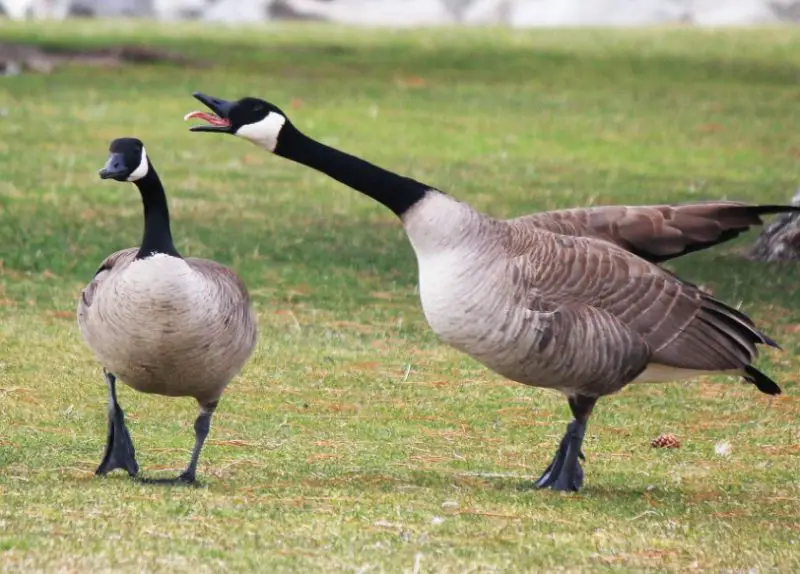
The Canada Goose is a large, easily recognizable waterfowl with a black head and neck, white cheek patch, and brownish-gray body. Its long, black neck and honking voice make it a familiar sight across North America. Adults typically measure 30–43 inches in length, with an impressive wingspan of 50–67 inches, making them one of the largest birds regularly seen in Utah’s wetlands and urban parks.
Their call is a loud, honking “a-honk! a-honk!” often heard in flight or when gathered in groups. Canada Geese are highly social, forming strong family units that stay together during migration and through the winter. They are primarily grazers, feeding on grasses, aquatic plants, and agricultural grains. During migration seasons, their distinctive V-shaped flying formations are a common sight in the sky.
In Utah, Canada Geese are widespread and common year-round in a variety of aquatic habitats, including lakes, reservoirs, ponds, golf courses, and agricultural fields. They breed near water bodies across the state and are especially abundant around the Great Salt Lake, Utah Lake, and throughout the Wasatch Front. While some migrate seasonally, many geese now remain in Utah all year due to reliable food sources and mild winters.
Mallard
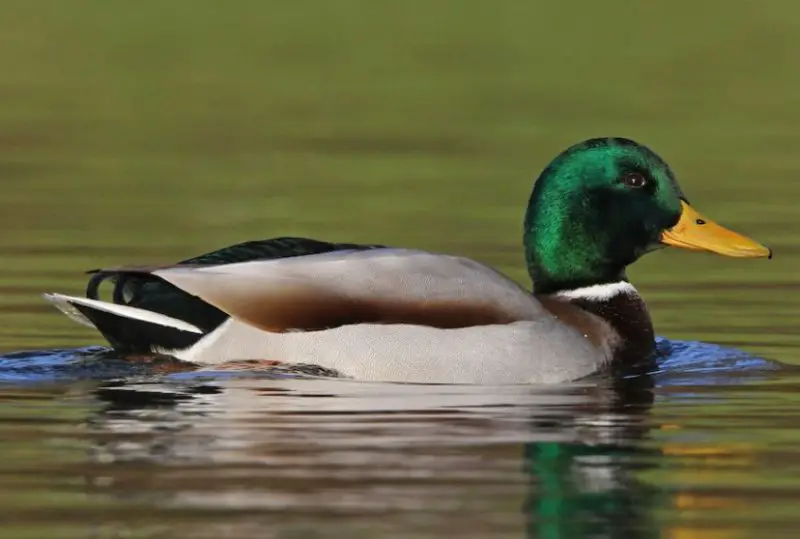
The Mallard is a familiar and widespread dabbling duck, with males exhibiting a glossy green head, white neck ring, chestnut-brown chest, and grayish body. Females are mottled brown with orange bills and blue speculums on the wings. Mallards are medium to large ducks, measuring 20–26 inches in length with a wingspan of 32–39 inches. Their strong flight and adaptability make them among the most common ducks in North America.
Males produce a quiet, raspy whistle, while females deliver the familiar loud “quack-quack” that’s often associated with ducks in general. Mallards feed by tipping forward in shallow water to eat aquatic vegetation, insects, and seeds. They are also common at urban ponds where they eagerly accept food from people, although feeding waterfowl is generally discouraged.
Mallards are found throughout Utah in both wild and urban settings. They are year-round residents in many parts of the state, especially near wetlands, ponds, marshes, and rivers. Breeding pairs can be seen in spring and summer near nesting sites close to water. During migration seasons, their numbers increase significantly across the Great Salt Lake basin and other key wetland habitats.
Great Blue Heron
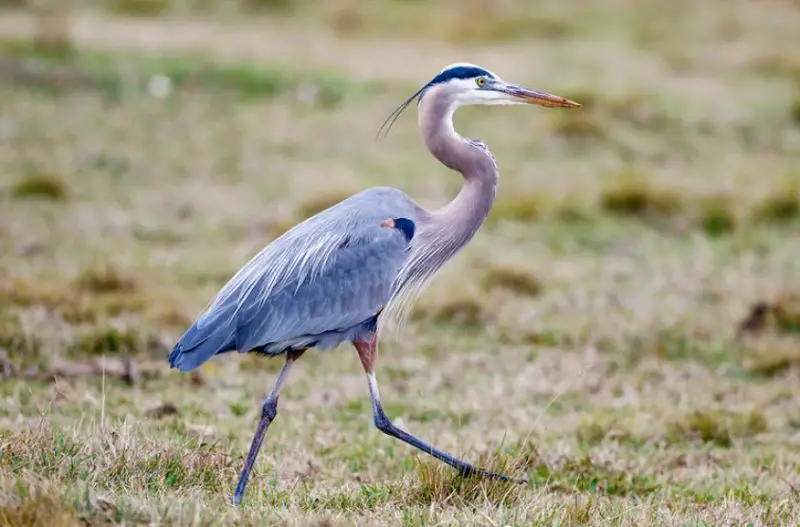
The Great Blue Heron is a tall, majestic wading bird with long legs, a dagger-like yellow bill, and blue-gray plumage. It stands around 4 feet tall and has a wingspan that can exceed 6.5 feet. In flight, its long neck folds into an S-shape, and its slow, deliberate wingbeats make it a graceful sight over water. A black stripe extends from above the eye to the back of the head, forming a plume in breeding adults.
Its call is a deep, harsh “fraaawk” or “grawnk,” often heard as it takes flight. Great Blue Herons feed primarily on fish, amphibians, and aquatic invertebrates, hunting patiently by standing still or slowly stalking in shallow water. They are solitary feeders but gather in colonies, called heronries, for nesting in tall trees near water.
In Utah, Great Blue Herons are common in wetland areas, lakeshores, and riverbanks throughout the state, including the Bear River Migratory Bird Refuge, the Jordan River, and Utah Lake. They are present year-round in many regions, especially where water remains unfrozen in winter. Their tall, statuesque form is often seen silently surveying the water’s edge.
Killdeer

The Killdeer is a medium-sized plover with striking markings, including two black bands across the white breast, a tawny-brown back, and a reddish-orange rump visible in flight. Its large, dark eyes, slender profile, and long legs make it an agile and distinctive shorebird. Adults measure about 8–11 inches long, with a wingspan of 18–24 inches.
Killdeer are highly vocal birds, known for their sharp, loud “kill-deer!” call that carries over open landscapes. They use this call in flight and when alarmed. On the ground, they are known for their broken-wing distraction display, where they feign injury to lure predators away from their nest, which is often a simple scrape in gravel or open ground.
In Utah, Killdeer are widespread and found in a wide range of habitats including mudflats, fields, deserts, gravel roads, and shorelines. They are year-round residents in much of the state, especially in the valleys and around water bodies, although some individuals migrate farther south for winter. Their adaptability to open ground makes them one of Utah’s most commonly seen shorebirds.
Common Raven
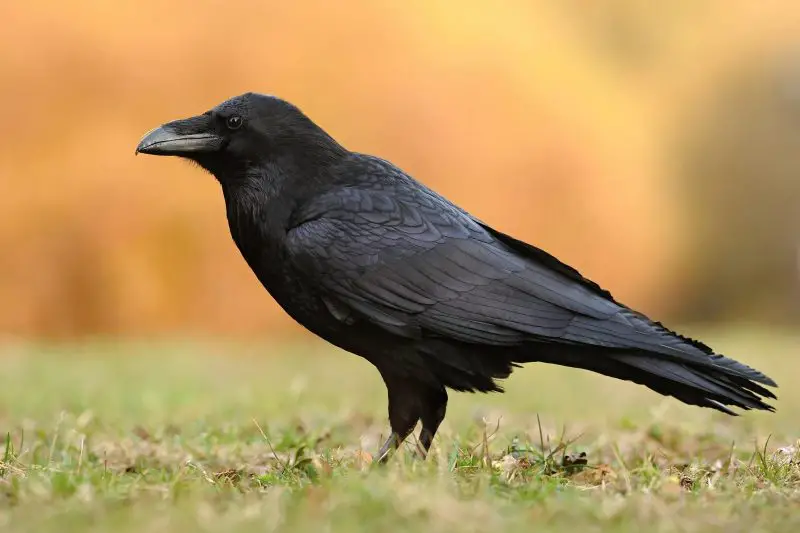
The Common Raven is a large, all-black bird with a thick neck, shaggy throat feathers, and a hefty, curved bill. It is one of the largest passerines in North America, measuring 22–27 inches long with a wingspan of up to 4.5 feet. Its wedge-shaped tail and acrobatic flight distinguish it from other black birds like crows.
Ravens are highly vocal and intelligent, with a wide range of calls including deep, resonant “croaks,” rattles, knocks, and mimicry. Their communication is complex and often used in social interactions. Common Ravens are known for their problem-solving skills, playful behavior, and even using tools. They feed opportunistically on carrion, small animals, insects, and food scraps.
In Utah, Common Ravens are found in almost every region, from desert canyons and cliffs to forests and mountain peaks. They are especially common in southern Utah’s red rock country, where they soar over canyons like Zion, Bryce, and Arches. Their adaptability and intelligence have made them successful residents in both wild and human-altered environments across the state.
Western Meadowlark

The Western Meadowlark is a chunky, robin-sized songbird with a bright yellow belly and throat marked by a bold black “V” on the chest. Its upperparts are streaked brown, helping it blend in with dry grasses and open fields. The outer tail feathers are white and flash in flight, and its long, slender bill is slightly downcurved. Adults measure 8–11 inches long with a wingspan of 14–16 inches.
Its song is among the most beautiful of North American birds—a rich, flute-like series of whistles that carry across meadows and grasslands. Calls include sharp “chupp” or “tew” sounds used for alarm or contact. Males sing frequently during the breeding season from fence posts or shrubs to mark territory and attract mates.
Western Meadowlarks are widespread in Utah’s open country, particularly in agricultural lands, grasslands, and high desert plateaus. They are most common in the northern and central parts of the state and are often seen standing on roadside posts or walking through fields. While some individuals migrate southward in winter, many remain in Utah year-round in milder lowland areas.
Barn Swallow

The Barn Swallow is a sleek, agile bird known for its graceful flight and deeply forked tail. It has a dark blue back and wings, cinnamon-orange underparts, and a reddish throat and forehead. Its long, pointed wings and streamlined shape make it an exceptional flyer. Adults measure about 6.5–7 inches long with a wingspan of around 12–13 inches.
Barn Swallows have a cheerful, twittering song made up of a series of chirps and gurgling notes, often delivered in flight. Their calls are a variety of rapid twitters and squeaky notes. They are highly aerial, feeding on flying insects that they catch while swooping and gliding through the air, often in flocks.
In Utah, Barn Swallows are common during the warmer months, nesting under bridges, eaves, barns, and other structures. They are especially abundant in rural areas with open fields, near water, or in agricultural zones. These birds migrate to Central and South America in winter and return to Utah each spring to breed, often reusing old nests year after year.
Western Tanager

The Western Tanager is a strikingly colorful songbird with a brilliant yellow body and contrasting black wings. Males in breeding plumage have a vivid red-orange head, while females are more olive-yellow with faint wing bars. These medium-sized birds measure about 6.5–7.5 inches long and have a wingspan of 11–12 inches. Their eye-catching colors make them one of the most beautiful birds in western North America.
Their song is a short, musical series of rising and falling notes that resemble an American Robin’s tune but less fluid. They also give dry “pit-er-ick” calls and harsh “chup” notes. Western Tanagers forage in the canopy, picking off insects, spiders, and berries. Despite their bright plumage, they can be surprisingly hard to spot among dense foliage.
In Utah, Western Tanagers are most commonly found during migration and summer breeding season in coniferous forests, woodlands, and mountain slopes, especially in the Wasatch and Uinta ranges. They are more elusive in the lowlands but occasionally pass through backyards with fruiting trees or feeders. These birds typically migrate to Mexico and Central America for winter.
Lazuli Bunting
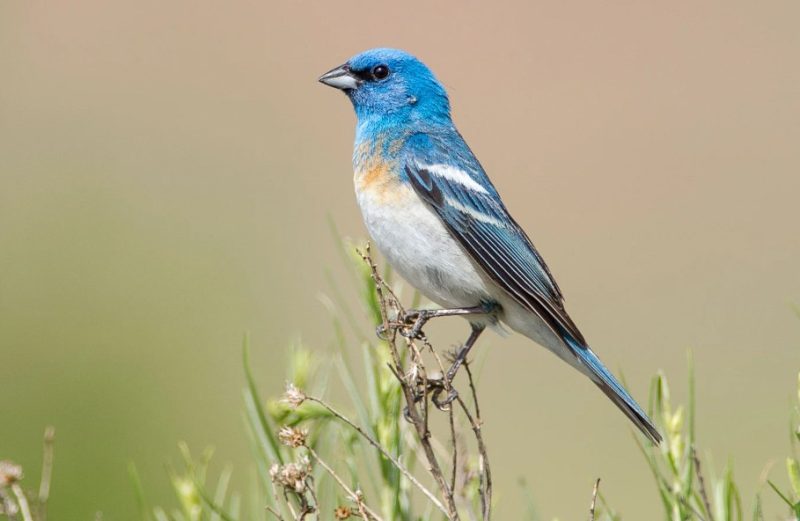
The Lazuli Bunting is a small, sparrow-sized songbird with vivid coloring. Males are unmistakable in breeding season, displaying a sky-blue head and back, white belly, and rusty-orange breast. Females and immature birds are warm brown with pale underparts and faint blue tinges on the wings or rump. Adults measure about 5.5 inches in length with a wingspan of 8 inches.
Their song is a fast, sweet series of warbled phrases that resemble a compressed goldfinch or sparrow song. Males sing frequently from exposed perches in spring and early summer. Lazuli Buntings forage on the ground and in low shrubs for seeds and insects, often flicking their tails and giving sharp “tick” calls when alarmed.
Lazuli Buntings breed widely in Utah, especially in shrubby areas, forest edges, foothills, and canyon bottoms. They are often seen in the central and northern parts of the state during late spring and summer. Their striking colors and sweet songs make them a favorite of bird watchers. Most migrate to Mexico for the winter, departing Utah by late August.
Black-capped Chickadee

The Black-capped Chickadee is a tiny, energetic bird with a large round head, black cap and bib, white cheeks, and soft gray back and flanks. It measures around 4.5–5.5 inches long with a wingspan of 6–8 inches. Its curious and approachable behavior makes it a favorite among backyard birders.
This bird’s familiar “chick-a-dee-dee-dee” call varies in intensity depending on the level of alarm, and its whistled song, “fee-bee” or “hey sweetie,” is heard during spring. Chickadees are acrobatic foragers, often hanging upside-down from branches while searching for insects, seeds, and berries. They cache food in hidden spots and remember its location for days or weeks.
Black-capped Chickadees are year-round residents in northern and central Utah, especially in woodlands, suburban yards, and riparian forests. They are common along the Wasatch Front and in forested canyons. In winter, they often join mixed-species flocks with nuthatches and kinglets, increasing their chances of finding food and avoiding predators.
Mountain Chickadee

The Mountain Chickadee is a small, plump songbird with a black cap and bib, white cheeks, and a distinctive white stripe above the eye, which sets it apart from the Black-capped Chickadee. Its back and wings are gray, and the underparts are pale gray to buff. Adults measure about 5.5–6 inches long with a wingspan around 8 inches. Their quick, agile movements and curious nature make them favorites in mountain forests.
Their call is a buzzy, hoarse version of the familiar “chick-a-dee-dee,” and their song is a clear, descending “fee-bee-bay.” Mountain Chickadees are active and acrobatic foragers, often hanging from branches while gleaning insects and seeds. They also cache food for later use and can remember hundreds of hiding spots, especially helpful during winter.
In Utah, Mountain Chickadees are year-round residents of coniferous forests, especially at mid to high elevations in the Wasatch and Uinta mountains. They are most common in spruce, fir, and pine woodlands but will occasionally visit feeders in nearby mountain towns. During colder months, they form mixed-species flocks with nuthatches and kinglets to increase foraging efficiency.
Pinyon Jay
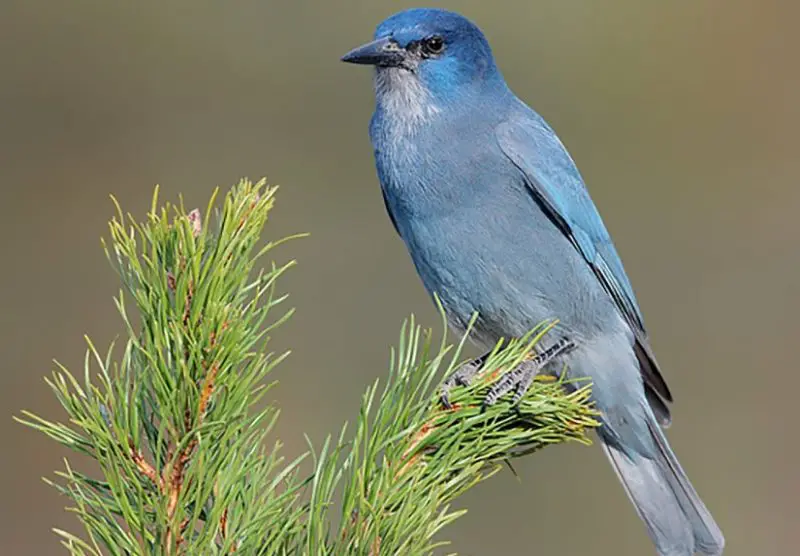
The Pinyon Jay is a medium-sized, crestless jay with overall dusty blue plumage, a slightly lighter belly, and a long, straight bill. Its head and neck are darker blue, and its tail is shorter than that of most other jays. Adults typically measure about 10–11 inches long with a wingspan of around 18 inches. This jay often travels in noisy, tight-knit flocks.
Its voice is a harsh, nasal “kaw” or “raaah,” and Pinyon Jays are often heard before they are seen. They are highly social and intelligent, communicating through a variety of vocalizations. These jays are important to Utah’s pinyon-juniper ecosystem, where they feed heavily on pinyon pine seeds and help disperse them by caching thousands in scattered locations.
Pinyon Jays are found in central and southern Utah, especially in dry foothills and desert woodlands dominated by pinyon pine and juniper trees. Areas like Capitol Reef, Cedar Mesa, and San Rafael Swell offer prime habitat. They are often nomadic, moving in flocks to follow food sources, and are more irregular in occurrence than some other jays.
Western Scrub-Jay (California Scrub-Jay)

The Western Scrub-Jay, now more accurately called the California Scrub-Jay in Utah, is a striking blue-and-gray bird with a long tail, bold white eyebrow, and lack of a crest. The back and wings are bright blue, while the underparts are grayish-white and the throat is faintly outlined with a blue necklace. Adults are about 11–12 inches long with a wingspan around 15 inches.
These jays are vocal and intelligent, often heard giving raspy “shreeeeh” calls and a variety of harsh chatters and squawks. They are known for their curiosity and excellent memory, especially when caching acorns or other seeds for later use. Scrub-Jays are also bold around humans and are frequent visitors to bird feeders and campsites.
In Utah, the California Scrub-Jay is most commonly found in the western and southern parts of the state, especially in dry scrublands, oak woodlands, pinyon-juniper zones, and suburban areas. They are regular residents in places like St. George, Zion National Park, and the Great Basin foothills. Unlike forest jays, they prefer open, brushy habitats and lower elevations.
Steller’s Jay
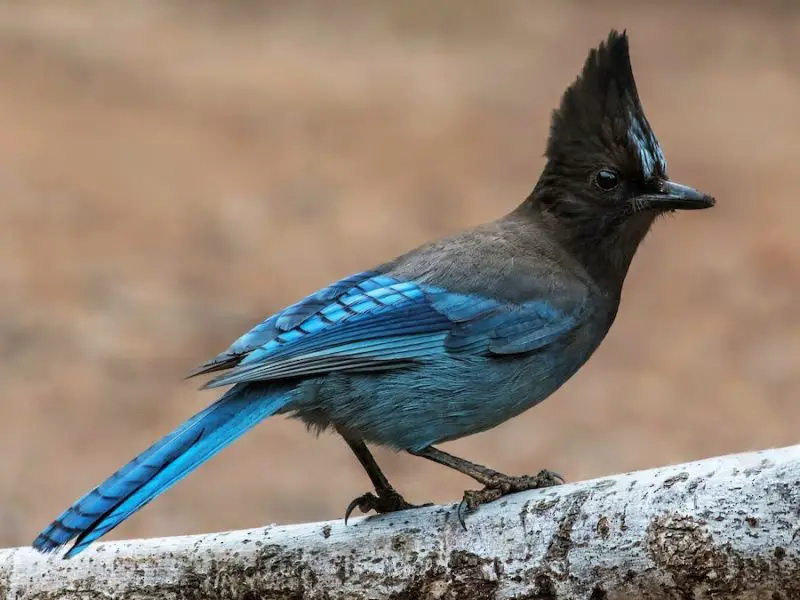
The Steller’s Jay is a large, striking bird with deep blue body feathers and a blackish head adorned with a prominent crest. It has bright blue barring on the wings and tail and a strong black bill. Adults measure 11.5–13 inches long with a wingspan of around 17 inches. Their dramatic appearance and loud voice make them one of the most recognizable birds in Utah’s mountain forests.
Their vocalizations include harsh “shack-shack-shack” calls, mimicked sounds, whistles, and occasional imitations of hawks. Steller’s Jays are bold and opportunistic, often visiting campsites, feeders, and picnic areas in search of food. They are omnivorous, eating seeds, berries, insects, small animals, and even raiding nests for eggs or chicks.
In Utah, Steller’s Jays are primarily found in coniferous and mixed forests of the Wasatch and Uinta mountains. They prefer mid- to high-elevation forests with spruce, fir, or ponderosa pine and are seen throughout the year. Their loud presence and social behavior make them common companions in mountain trails and forested campgrounds.
Say’s Phoebe
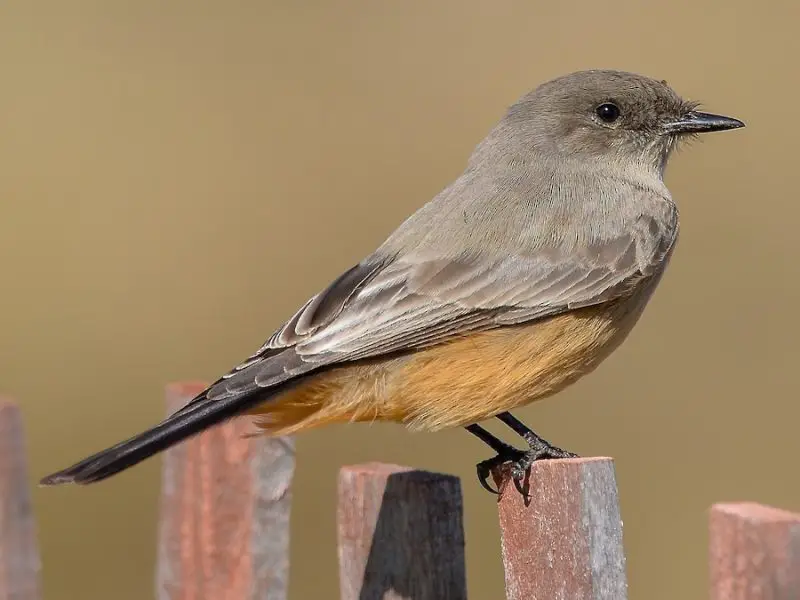
Say’s Phoebe is a slender, medium-sized flycatcher with soft brownish-gray upperparts, a black tail, and a warm cinnamon-colored belly and undertail. It lacks wing bars and has a somewhat square-headed profile. Adults measure about 6.5–7.5 inches long with a wingspan of around 12 inches. Its subtle but attractive coloration sets it apart from other more vividly marked flycatchers.
The song of Say’s Phoebe is a quiet, descending whistle, and its call is a sharp “pit” or “chip,” often repeated as the bird perches and sallies out to catch insects. Like other phoebes, it frequently pumps its tail up and down while perched. Say’s Phoebe feeds primarily on flying insects, launching short, graceful flights from fences, shrubs, or buildings.
Say’s Phoebes are widespread across Utah in open habitats such as deserts, grasslands, sagebrush flats, and canyons. They are early migrants, often returning by late February or March to begin breeding, and are known for nesting under bridges, rafters, or porch eaves. Common across both northern and southern Utah, they are one of the state’s most visible flycatchers in open country.
Ash-throated Flycatcher
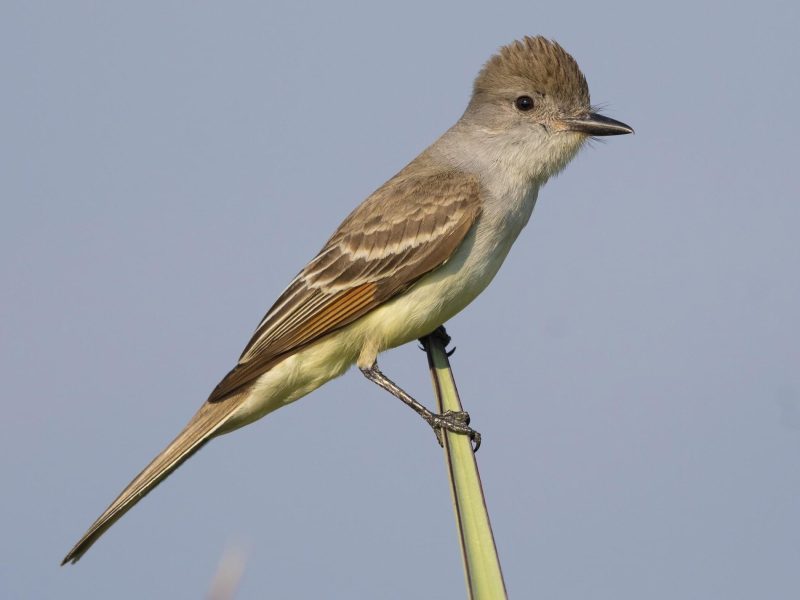
The Ash-throated Flycatcher is a slender, medium-sized flycatcher with pale gray upperparts, a whitish throat and breast, and soft yellow on the belly. It has a slightly crested head, a rufous tail with darker edges, and two faint wing bars. Adults measure about 7.5–8.5 inches long with a wingspan around 12–13 inches. Though subtly colored, its combination of soft earth tones is distinctive.
Its call is a dry, burry “prrrt” or “ka-brik,” often repeated and given from exposed perches. It also gives a soft “wheeep” or whistled call during flight. Ash-throated Flycatchers are agile insect hunters, sallying out from low branches to catch prey in midair or gleaning from leaves. They often nest in cavities, including old woodpecker holes or man-made nest boxes.
In Utah, this species is a summer breeder in dry, open habitats such as desert scrub, pinyon-juniper woodlands, and canyon edges. It is particularly common in the southern and central parts of the state, including areas like Capitol Reef and Zion National Park. Most individuals migrate south by early fall to spend winter in Mexico and Central America.
American Kestrel
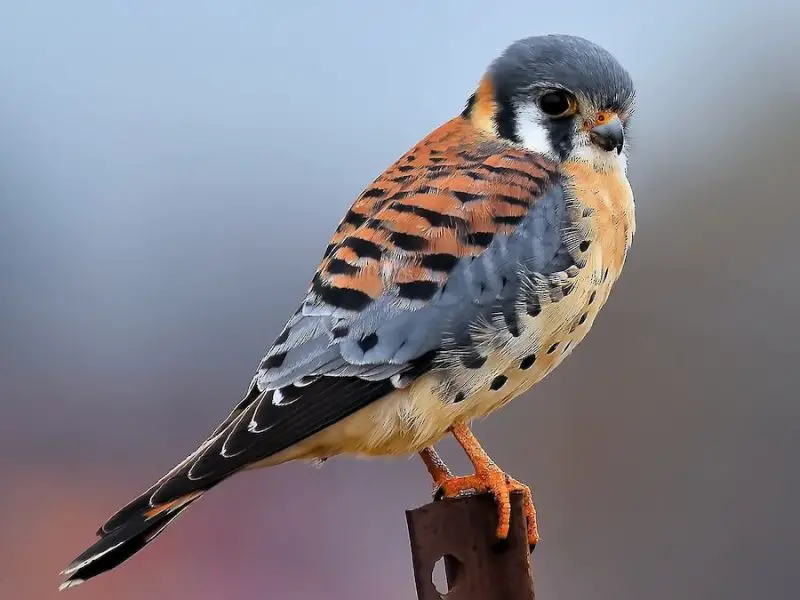
The American Kestrel is North America’s smallest falcon, known for its compact size and colorful plumage. Males display blue-gray wings, a rusty back and tail, and bold facial markings, while females are rusty overall with dark barring. Both sexes have black vertical streaks on the face and measure about 8–11 inches long with a wingspan of 20–24 inches.
Their voice is a rapid, high-pitched “klee-klee-klee,” especially during the breeding season or when alarmed. Kestrels often hover in midair while scanning for prey, a behavior called “kiting.” They feed on insects, small mammals, and occasionally small birds, using perches such as power lines or fence posts to hunt.
American Kestrels are common across Utah year-round, especially in open fields, deserts, farmlands, and urban edges. They nest in cavities, including tree holes and nest boxes, and are often seen along roadsides and in rangelands. Their adaptability to open habitats and striking appearance make them one of Utah’s most visible birds of prey.
Turkey Vulture

The Turkey Vulture is a large scavenger with long, broad wings, a featherless red head, and dark brown-black plumage. It soars with its wings in a distinctive shallow “V” shape, called a dihedral, and rocks side to side in flight. Adults measure about 25–32 inches long with a wingspan up to 6 feet.
They are silent most of the time, lacking a syrinx (voice box), but may produce low hisses and grunts at close range. Turkey Vultures rely on an extraordinary sense of smell to locate carrion, often circling high above the landscape to detect the scent of decaying animals. They rarely flap their wings and can remain aloft for long periods with minimal effort.
In Utah, Turkey Vultures are common during the warmer months in open country, deserts, and canyons, especially near roadsides and rocky outcrops. They are widespread across the state from spring through early fall, including areas like Zion, Arches, and the Uinta Basin. Most vultures migrate south for the winter, but a few may linger in southern Utah during mild seasons.
Bald Eagle (primarily in winter)
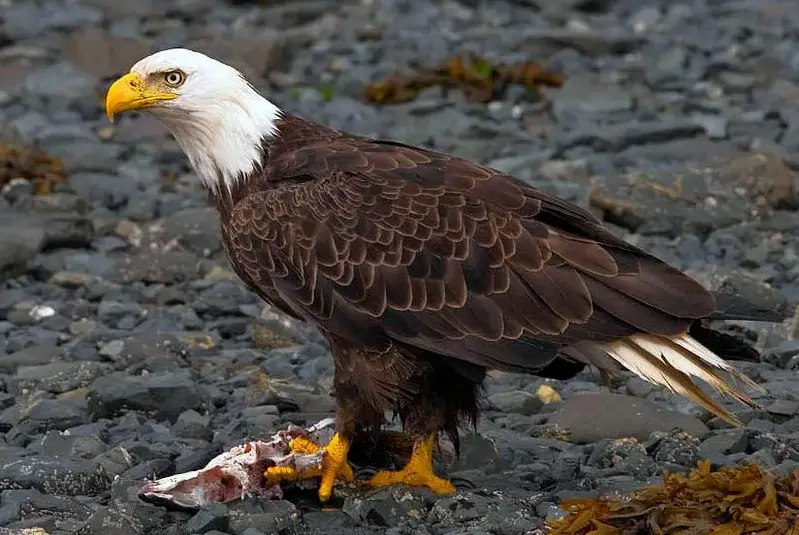
The Bald Eagle is a powerful raptor with a striking white head and tail, dark brown body and wings, and a massive yellow beak. Immature birds are mostly dark with mottled white and brown plumage and do not acquire full adult coloring until age 4–5. Adults measure 28–38 inches long with a wingspan of 6.5–8 feet, making them one of the largest birds in North America.
Their calls are surprisingly thin and high-pitched, sounding like a sharp whistling or squealing series of notes, often heard during courtship or territorial disputes. Bald Eagles are primarily fish-eaters but also scavenge carrion and may steal prey from other birds. They often perch in tall trees near water and are impressive in flight with slow, deep wingbeats.
In Utah, Bald Eagles are mostly seen in winter, when they migrate from northern breeding grounds to ice-free lakes and rivers. The Great Salt Lake, Utah Lake, and the Green and Colorado Rivers are popular wintering areas. Eagle-viewing events are often held in January and February in places like Farmington Bay and the Bald Eagle Day in central Utah.
Northern Harrier
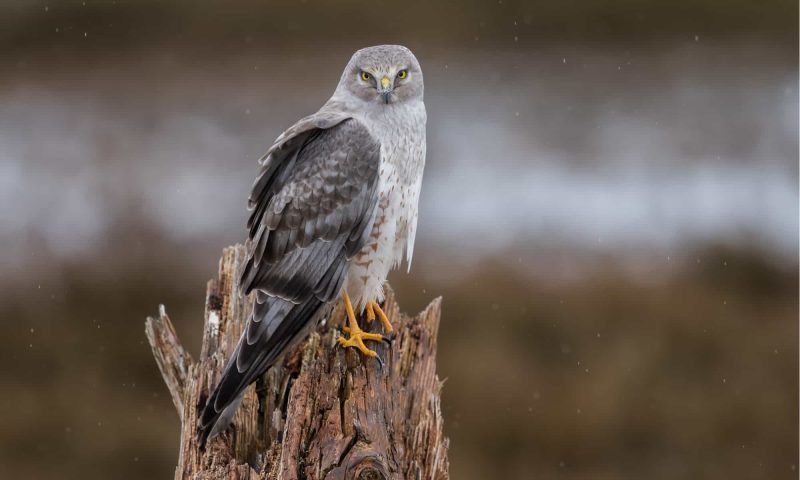
The Northern Harrier is a slim, long-winged raptor with an owl-like face, long tail, and a distinctive white rump patch visible in flight. Males are pale gray above with lighter underparts, while females and juveniles are brown with buffy streaking. Adults measure about 18–20 inches long with a wingspan of 40–46 inches. They fly low over open fields with graceful, tilting wingbeats.
Their calls include a sharp “kek-kek-kek,” often given during courtship or territory defense. Harriers are unique among hawks for their facial disk, which helps them detect prey by sound, much like owls. They hunt by flying low over grasslands and marshes, capturing small mammals, birds, and amphibians with quick dives.
Northern Harriers are widespread across Utah’s open habitats such as wetlands, marshes, grasslands, and sagebrush plains. They are more common in winter and migration periods, especially in areas like Fish Springs, Bear River Refuge, and the west desert. Some individuals nest in northern Utah, where extensive marshlands provide good breeding conditions.
Swainson’s Hawk

Swainson’s Hawk is a large, graceful raptor notable for its broad wings and long tail. Adults have a pale, creamy chest and belly contrasting with darker brown wings and back. Some individuals show a “dark morph” with almost entirely dark plumage. They measure about 19–24 inches long with a wingspan ranging from 48 to 60 inches. Swainson’s Hawks are known for their soaring flight during migration and breeding.
Their call is a sharp, raspy “ka-ree” or “kree-ah,” often repeated in flight or during courtship displays. These hawks are migratory, traveling thousands of miles to winter in South America. They primarily feed on small mammals, insects (especially grasshoppers), and occasionally reptiles, often hunting by soaring high and then swooping down to capture prey.
In Utah, Swainson’s Hawks are mostly seen during the breeding season from spring through summer in open habitats such as grasslands, agricultural fields, and shrublands, especially in the southern and central parts of the state. They are notable summer residents of the Great Basin and Colorado Plateau regions before migrating south in the fall.
Chipping Sparrow

The Chipping Sparrow is a small, slender sparrow with a rusty-red cap, black eye line, and clean grayish underparts. It has a long, slim bill and a somewhat pale, unstreaked breast, making it easily distinguishable during the breeding season. Adults measure about 4.5–5 inches in length with a wingspan near 7.5–8.5 inches.
Their song is a rapid, rhythmic trill that sounds like a high-pitched mechanical buzz, often repeated from exposed perches. Calls include sharp “chip” notes, which give the species its common name. Chipping Sparrows forage on the ground and in low vegetation, eating seeds and insects, and are commonly seen at feeders during migration and winter.
In Utah, Chipping Sparrows are abundant breeders in open woodlands, parks, and suburban yards throughout the state, especially in the mountains and foothills. They are present from spring through fall, often arriving in early spring and departing by late fall to winter farther south.
White-crowned Sparrow
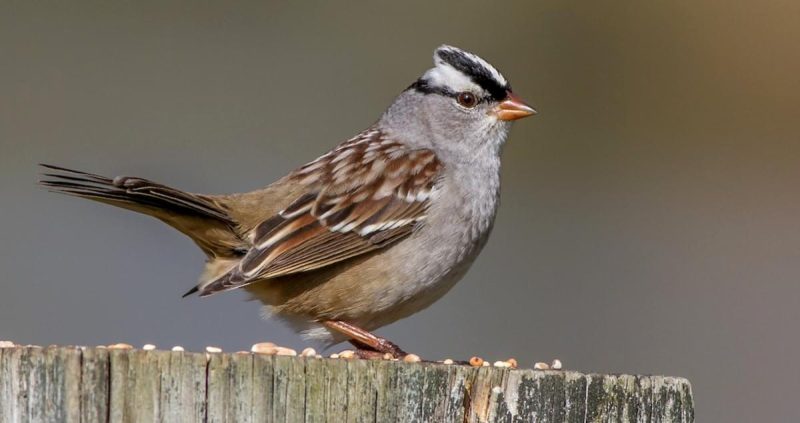
The White-crowned Sparrow is a medium-sized sparrow easily recognized by its striking black-and-white striped crown and gray face. Its back is brown streaked with black, and the underparts are pale gray to white. Adults measure about 6–7 inches long with a wingspan of 8–10 inches. Juveniles have a duller, brownish crown and less distinct markings.
Their song is a clear, musical whistle with a variable pattern but often starting with two or three clear notes followed by trills. They also produce sharp “chip” calls. White-crowned Sparrows forage on the ground for seeds and insects and are often seen scratching leaf litter. They frequent open areas with shrubs, weedy fields, and edges of forests.
In Utah, White-crowned Sparrows are common migrants and winter residents, especially in valleys and lower elevations. They breed mostly in higher elevations of the mountains but spend the winter in open habitats including agricultural lands and suburban areas. Their presence is especially noticeable during migration periods in spring and fall.
Yellow-rumped Warbler
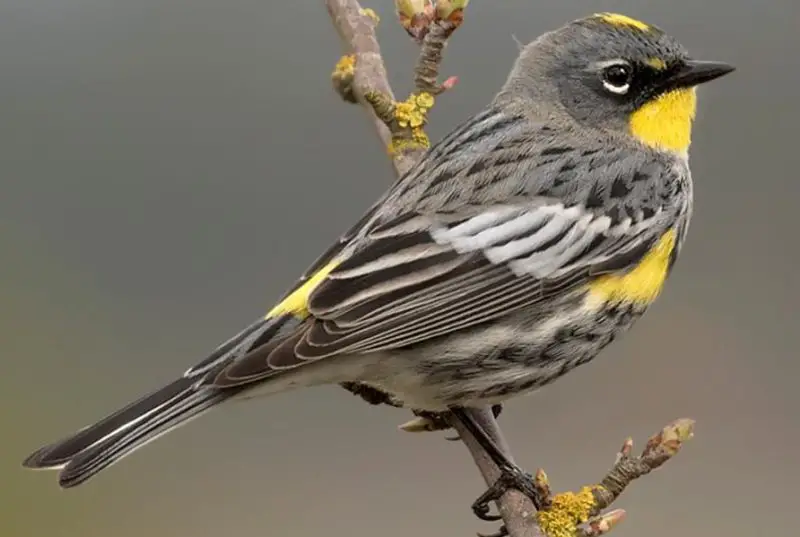
The Yellow-rumped Warbler is a medium-sized warbler with distinctive yellow patches on the rump, sides, and sometimes the crown. In Utah, the “Audubon’s” subspecies is common, showing streaked gray-brown plumage with a white throat and yellow highlights. Adults measure about 5–6.5 inches long with a wingspan of 8–10 inches. Their active, fluttering flight and bright colors make them easy to spot during migration.
Their song is a rapid, buzzy trill followed by a sharp “check” note, and their calls include sharp “chip” sounds. Yellow-rumped Warblers forage actively in trees and shrubs for insects and berries and are unique among warblers for eating waxy bayberries and wax myrtle fruits during winter. They often form mixed-species flocks outside the breeding season.
In Utah, Yellow-rumped Warblers are common migrants and winter visitors, frequenting forests, parks, and shrublands. They breed primarily in higher elevation conifer forests such as the Uinta and Wasatch ranges. During migration, they can be seen across a wide range of habitats statewide.
Cedar Waxwing

The Cedar Waxwing is a sleek, medium-sized songbird with a soft, silky brown and gray body, a yellow-tipped tail, and bright red waxy tips on the secondary wing feathers. It has a distinctive black mask edged in white and a crest on the head. Adults measure about 6–7 inches long with a wingspan around 8–10 inches. Their elegant appearance and social behavior make them a favorite among birders.
Their vocalizations are high-pitched, thin whistles and trills, often given in flight or while perched in flocks. Cedar Waxwings are highly frugivorous, feeding primarily on berries and fruits but also consuming insects during the breeding season. They often feed in loose flocks and are known for passing berries to each other in a unique social behavior.
In Utah, Cedar Waxwings are found year-round in riparian woodlands, suburban areas, and open forests across the state. They breed mainly in shrublands and wooded areas near water, especially in spring and summer. Their presence is particularly notable in fall and winter when they gather in large flocks to feast on fruiting trees and shrubs.
Horned Lark

The Horned Lark is a small, sparrow-sized bird with distinctive black “horns” — small feather tufts on its head — and a black mask across its face. Its plumage is sandy brown with a pale yellow throat and breast, blending well with open, arid habitats. Adults measure about 6.5–8 inches long with a wingspan of 12–14 inches, giving it a delicate, slender appearance.
Horned Larks are known for their melodious, tinkling song that includes clear, high-pitched notes and trills often delivered during flight displays. Their calls include soft “tseep” sounds. They forage mostly on the ground, feeding on seeds and insects, and are well adapted to life in open plains, deserts, and agricultural fields.
In Utah, Horned Larks are widespread and common year-round, particularly in open habitats such as the Great Basin deserts, sagebrush flats, and agricultural lands. They are often seen in flocks, especially during winter months, and breed in these same open, sparsely vegetated areas across much of the state.
Northern Mockingbird
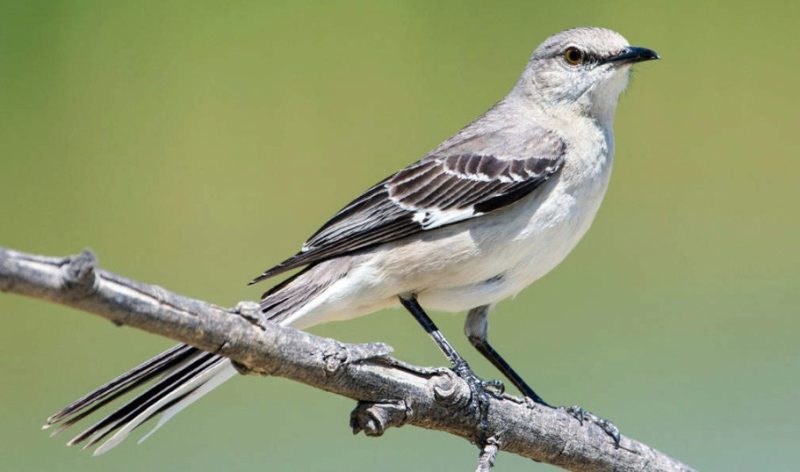
The Northern Mockingbird is a medium-sized, gray bird with a slender body, long tail, and white wing patches that flash conspicuously in flight. Adults measure about 9–11 inches long with a wingspan of 12–15 inches. They have a plain gray back and lighter underparts, with a sharp, slightly curved bill.
Mockingbirds are famous for their extensive vocal repertoire, able to mimic the songs and calls of many other bird species, as well as mechanical sounds. Their song is a varied mix of whistles, trills, and repeated phrases, often sung from exposed perches. They are territorial and use song displays to defend their nesting areas.
Northern Mockingbirds are common residents throughout Utah, particularly in suburban neighborhoods, parks, desert scrub, and open woodlands. They nest in dense shrubs and trees and are especially abundant in the southern and western parts of the state. Their adaptability to human-altered landscapes makes them familiar and frequent backyard visitors.
Virginia’s Warbler

Virginia’s Warbler is a small, active songbird with soft gray plumage, a yellow belly, and a faint white eye ring. It has a subtle crest and a fine, thin bill suited for catching insects. Adults are around 4.5 inches long with a wingspan near 7 inches, making it one of Utah’s smaller warblers.
Their song is a rapid series of buzzy, musical notes often rising and falling in pitch. Calls include sharp “chip” sounds. Virginia’s Warblers forage energetically among shrubs and low trees, gleaning insects and spiders from foliage. They are generally shy and secretive, often heard more than seen.
In Utah, Virginia’s Warblers breed mainly in higher elevation oak and pinyon-juniper woodlands of the southern and central mountains. They arrive in late spring and depart by early fall, migrating to Mexico for winter. Their limited range and specialized habitat make sightings a treat for birdwatchers in appropriate forested habitats.
Bewick’s Wren
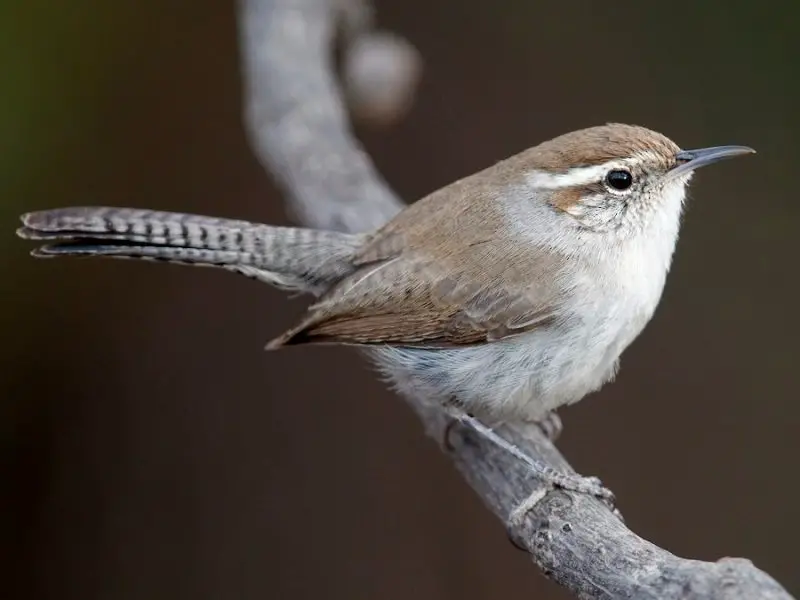
Bewick’s Wren is a small, lively bird with warm brown upperparts, pale underparts, and a distinctive long, slender tail often cocked upward. It has a bold white eyebrow stripe contrasting with its dark eye, and a thin, slightly curved bill. Adults measure about 5.5–6.5 inches long with a wingspan of around 8.5–10 inches.
Bewick’s Wrens have a loud, bubbly, and complex song consisting of varied whistles, trills, and rattles, often sung from prominent perches. Their calls are sharp “chek” or “tik” sounds. These wrens forage actively on or near the ground, probing into crevices and brush for insects and spiders. They nest in cavities, including natural holes or abandoned nests, and sometimes use nest boxes.
In Utah, Bewick’s Wrens are widespread residents in dry brushy habitats, open woodlands, and suburban areas across much of the state. They are especially common in foothills and canyons of the Wasatch Front and the southern deserts. Their adaptable behavior and bold song make them one of Utah’s most easily recognized wrens.
Canyon Wren
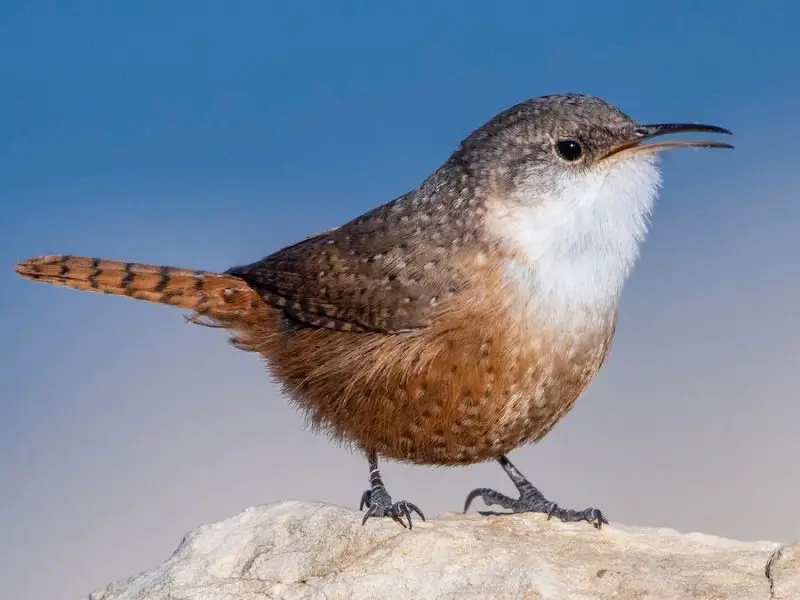
The Canyon Wren is a small, stocky bird known for its bright rusty-orange underparts and barred brown-gray back. It has a long, slightly curved bill and a relatively short tail. Adults measure about 5 inches in length with a wingspan around 7.5 inches. Their coloration provides excellent camouflage among rocky cliffs and canyon walls.
Their song is a series of clear, melodious, descending whistles that echo through rocky canyons and cliff faces, often heard far before the bird is seen. Calls are soft “chuck” notes. Canyon Wrens forage by hopping and creeping along rocky crevices and ledges, searching for spiders and insects. They are excellent climbers, using their strong legs and feet to navigate vertical surfaces.
In Utah, Canyon Wrens are primarily found in arid, rocky habitats including canyons, cliffs, and rocky outcrops throughout the southern and central parts of the state. They are year-round residents and a favorite sight and sound in places like Zion, Bryce Canyon, and the red rock country of southeastern Utah.


